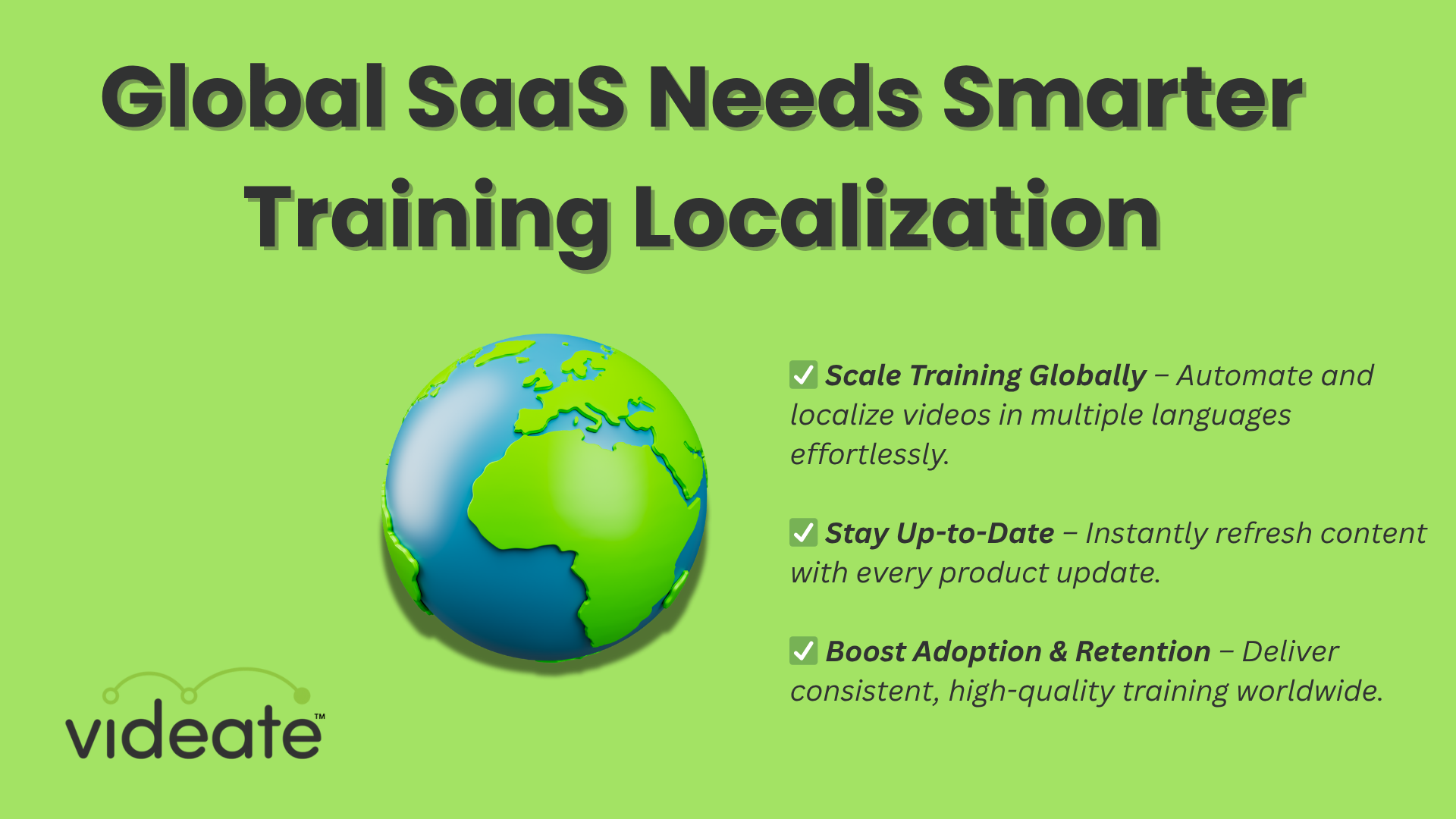
All business is global. Anyone with a cell phone has access to your products, your services, and your messaging. They could be right next door or in the middle of the Sahara desert. Plus, businesses themselves can set up shop anywhere in the world.
Translating your output to as many languages as possible has become an imperative for global reach and growth.
But, there are challenges, and time and money are at the top of the list.
Past Options for translating software videos
With a tech doc or help article, you can use a number of automated translation solutions from Google translate to Translation Management Systems. With video, you can include closed captions, which rely on text translation, and this is better than nothing. But historically, only two approaches have been available to create native language translation of videos.
- Dub the audio in another language.
The downside is that the movement and navigation are no longer fully synchronized to the actual software. Phrases in foreign languages are not the same length as your primary language and technical jargon will most often not be translated.
And with every software release you will need to redo the audio dubbing. It’s actually worse than watching a movie when the actors' voices and lips are totally out of sync with the movie and the title is not even close to the original!
- Re-record the video in each language you offer
This is definitely not scalable for most software developers in their primary language. The frequency of releases makes it cost prohibitive once you have multiple languages.
Recently, auto translation has become a reliable alternative to a human translator. Auto translation solutions are an obvious option for global companies that need to scale across multiple languages. And with their vastly improved capabilities and wide-spread use, auto translation is going to become the norm.
What is Auto Translation?
Auto translation is any computer-operated translation software that automatically translates in or near real time with little-to-no human effort.
Translations can be automatically generated in a few ways:
- Text-to-text: translating the text you provide into another language
- Audibly: translating the audio from someone speaking
- Visually: taking a picture or video and having the words in the image translate into another language. This can also be done using augmented reality.
Some of the big auto translators available include Google Translate, iTranslate Voice 3, and Microsoft Translator.
These apps are great for tourists visiting new places, but what about major companies that need to translate assets on a large scale, in multiple languages? There are programs that specialize in this too.
The History of Bad Auto Translation
![]() Auto translation has come a long way. Decades ago, it was clumsy and often just plain wrong (remember "All your base are belong to us"?)
Auto translation has come a long way. Decades ago, it was clumsy and often just plain wrong (remember "All your base are belong to us"?)
20 years ago, running this article’s title (“Auto Translation is the Future and the Future is Now”) through auto translate programs of old might have rendered something like this:
“The Machine Translation Will Come, and the Future is Up to Date.”
It’s…technically some of the words, but the the phrase itself doesn’t make sense.

We’ve come a long way since then. Now, translations are not only easier-to-access and faster, they are substantially more accurate. And they’ll only get better.
Where Auto Translation is Headed
Auto translation technology will continue to improve. We have already seen the recent developments of augmented reality, in-camera auto translation technology as well as an increase in the number of languages that can be translated in.
For instance, Google Translate can now translate in 133 languages. It can translate into 37 languages via photo, 32 via voice in "conversation mode", and 27 via live video imagery in "augmented reality mode".
Recently, they’ve added 24 new languages, including Dhivehi, spoken by about 300,000 people in the Maldives and Twi, used by about 11 million people in Ghana.
Eventually, all 4000 written and 7000 spoken languages will be available in translations. Even dead languages.
But where auto translation will be making its biggest leap is in machine learning. As programs further use AI, auto translation will soon be able to pick up on intent, based on the emphasis of how words are said. It will be better at understanding idioms, turns of phrases, and slang. And it could even make suggestions based on regional dialects and geographic location.
For instance, it will know whether you want to say ‘soda’ or ‘pop.’
In short, auto translation will be less like a dictionary and more like a true, human translator.
Eventually, language barriers will be a thing of the past. Maybe even in our lifetimes, given how quickly auto translation is improving. People will be able to instantly communicate with any person (and some verbose parrots) on earth, no matter where they are or what language they speak.
Even if auto translation isn’t perfect (yet), it is still extremely useful for spreading your content globally. With Google Translate, for instance, you can simply pop it into a spreadsheet and translate to 133 languages.
Solving the Translation Problem with Automation
You don’t need convincing that your customers want videos in their own language. Until now, it's been almost impossible to deliver videos for every customer in every language. Videate's realistic text to speech makes localization easy by providing a simple solution to producing How-To Videos In All Languages
Because Videate automates the production of software videos by starting with a script, the tools to translate your help articles or technical documentation can be applied to video translation.
When you translate the script, we regenerate the software video in the cloud by automatically re-synchronizing the software movement/navigation. In either the primary language or target language if you offer your product in multiple languages. Videate will create videos that can be maintained with each release by simply updating the script.
With Videate, you instantly update all your videos at once--including all of your different language videos. Automated software video translation has finally arrived.
Ready to localize your how-to video library?

From Customer to Teammate: My Journey with Videate


.png)